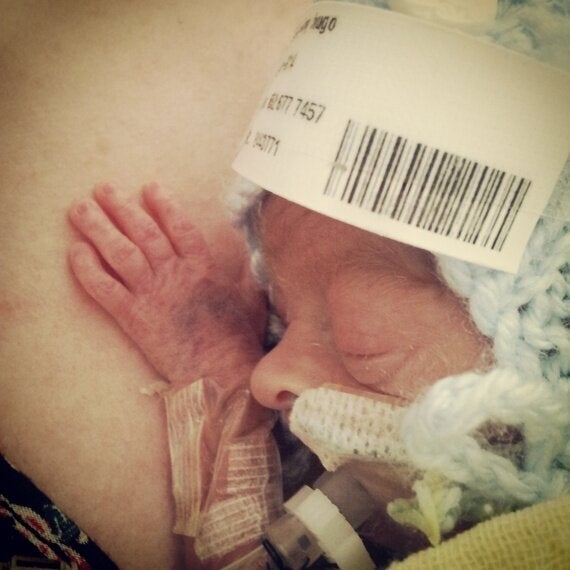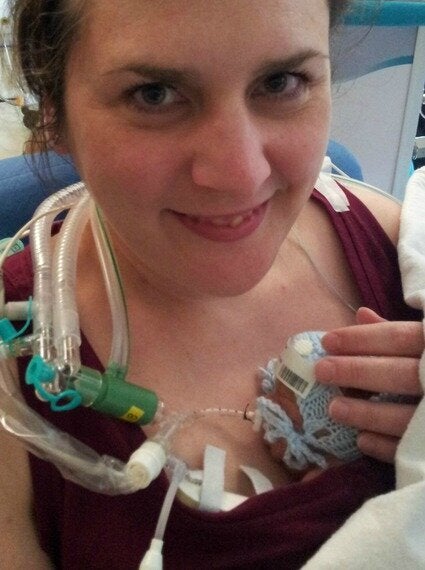My son Hugo died on March 27, 2014. He was just 35 days old.
Hugo had been born 16 weeks prematurely because I had the rare, life-threatening pregnancy complications HELLP syndrome and preeclampsia.
During the last few days of Hugo's life we were aware he was very sick (although I did not want to admit that to myself - I was holding on to every shred of hope). Hugo had chronic lung disease, and other issues relating to his extreme prematurity.
Every possible treatment had been tried for Hugo. Although steroid treatment had shown an initial benefit, he was effectively going backwards.

The day he died is forever etched in my memory. It was a Thursday: Grand Round day. A host of doctors gathered around Hugo's incubator. One doctor read the details of Hugo's condition and progress. The group of doctors would then make recommendations about next steps and treatment for the baby.
Each of the consultants gave their recommendation for Hugo: to withdraw treatment. Their decision was unanimous, no shadow of a doubt between them.
I was crumpled on the floor, sobbing and hyperventilating.
The way the news was delivered far from ideal. It is news that no parent wants to hear, but there are ways that would have been kinder, and less traumatic. I know the doctors did not mean to be unkind. They are kind, compassionate, and did everything possible for Hugo.
The main problem was the term 'withdrawing treatment', which is clinical and cold. It gave me a sense that we were putting our son down, as you might take a sick pet to the vets to get put out of their misery.
It was unthinkable.

When things had calmed down a little, we were able to have a conversation with a consultant about the hope Hugo had - or the lack of it. We were told all treatment options had been exhausted. While keeping Hugo alive on a ventilator was technically possible, to do so would be cruel to him, living in discomfort and cruel to us to live in false hope.
Not wanting to believe I would not be taking Hugo home, and utterly heartbroken, I remember asking the consultant if there really was no more hope. His reply was simple, emphatic, and kind: no.
The distinction in Hugo's care between 'there being no hope' and 'no further treatment' being worthwhile with 'nothing more can be done' is crucial. Nothing more could be done to save Hugo's life, but we were able to give him a good death.
As awful as these conversations were, as painful as it is to remember them and as difficult as it is to write this post, I am grateful to the doctors for their honesty. These conversations meant that the end of Hugo's life was able to be peaceful, and with the people who love him most: his mummy and his daddy.
Hugo hated being handled, and being poked and prodded by the doctors. He was at his calmest when he was on my chest, snuggled skin-to-skin between my boobs. Those conversations meant that my partner and I were able to do what we could do as parents for Hugo during his last moments.
My heartbeat was the first sound my son heard, and it was also the last.
During the first few nights following Hugo's death, I was plagued by nightmares - both waking and sleeping - that we had been too hasty, that we had not made the right decision, that there may have been other treatments to try. The memory of being told that one simple word about hope for Hugo: 'no' helped a little by providing a rational thought during those most painful of times.
In the event, as we discovered with a meeting with a consultant a couple of months after Hugo's death, his treatment wasn't really withdrawn as such: our son had told us, in his own way, that he had had enough of fighting. It is difficult to articulate what that knowledge meant to me: there is pride that my clever, feisty, tiny baby knew what he wanted and when right up to the end; and that I was able to comfort my son. To be a good mummy to him.
My message is this: the words that are chosen to deliver bad news are crucial to someone's memory of the event. There are better ways to give bad news than how happened with Hugo's care.
Equally, it is vital to reflect that when all options to save someone's life have been exhausted, it does not mean there is nothing more to be done: there are always options for compassionate end-of-life care.
Discussing and considering these options will not only help the person at the end of their life, but provide a small comfort to the bereaved in their heartache. That is a great gift.
This is an edited version of a post that was originally featured on the author's blog, Headspace Perspective.